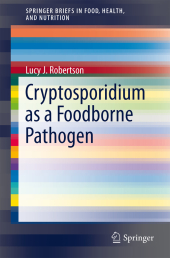 Neuerscheinungen 2013Stand: 2020-01-07 |
Schnellsuche
ISBN/Stichwort/Autor
|
Herderstraße 10
10625 Berlin
Tel.: 030 315 714 16
Fax 030 315 714 14
info@buchspektrum.de |

Lucy J. Robertson
Cryptosporidium as a Foodborne Pathogen
2014. 2013. vi, 90 S. 5 Tabellen. 235 mm
Verlag/Jahr: SPRINGER, BERLIN; SPRINGER NEW YORK 2013
ISBN: 1-461-49377-3 (1461493773)
Neue ISBN: 978-1-461-49377-8 (9781461493778)
Preis und Lieferzeit: Bitte klicken
Although widely recognized as an important waterborne pathogen, Cryptosporidium spp. can also be transmitted by contamination of food. The same properties of this protozoan parasite that mean that water is an excellent transmission vehicle are also important for foodborne transmission. These include the low infective dose, the high number of oocysts that are excreted, and the robustness of these transmission stages. However, many more outbreaks of waterborne cryptosporidiosis have been reported than foodborne outbreaks. This is probably partly due to epidemiological tracing being much more difficult for foodborne outbreaks than waterborne outbreaks, and the number of persons exposed to infection often being fewer. Nevertheless, the potential importance of foodborne transmission is gradually being recognized, and a wide range of different foodstuffs have been associated with those outbreaks that have been recorded. Additionally, various factors mean that the potential for foodborne transmission is becoming of increasing importance: these include the growth of international food trade, a current trend for eating raw or very lightly cooked foods, and the rise in small-scale organic farms, where there the possibility for contamination of vegetable crops with animal feces may be greater.
Introduction to Cryptosporidium - the parasite and the disease.- Transmission routes and factors that lend themselves to foodborne transmission.- Documented foodborne outbreaks of cryptosporidiosis.- Approaches to detecting Cryptosporidium oocysts in different food matrices.- Occurrence of Cryptosporidium oocysts in different food matrices: results of surveys.- Inactivation or decontamination procedures.- Risk assessment and regulations.- Future challenges.- Conclusions.- References.


